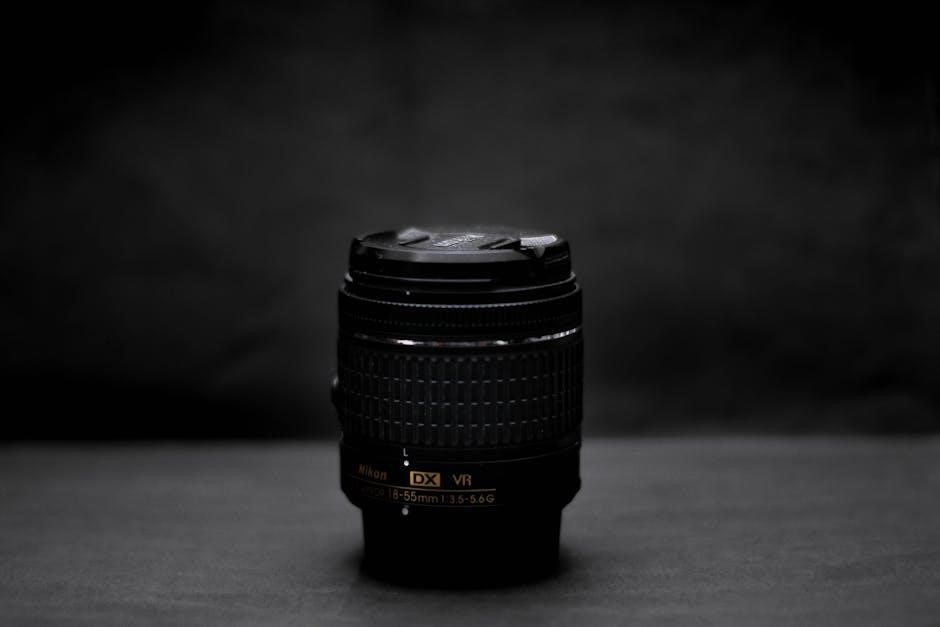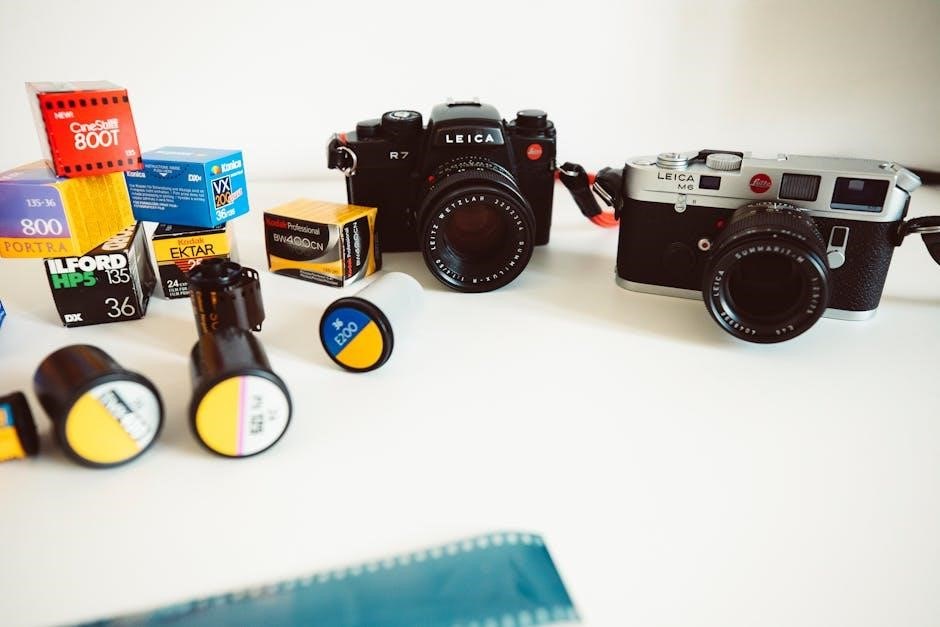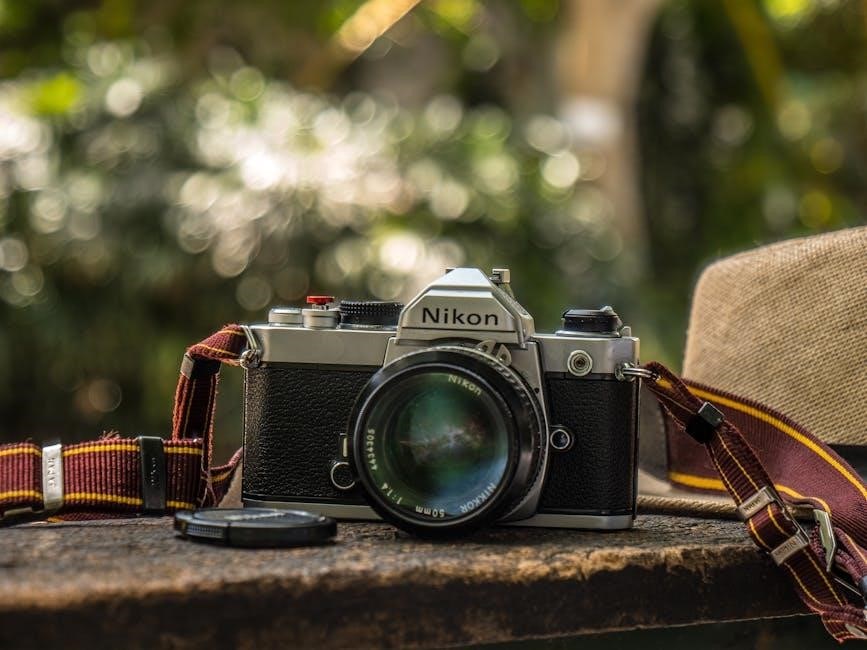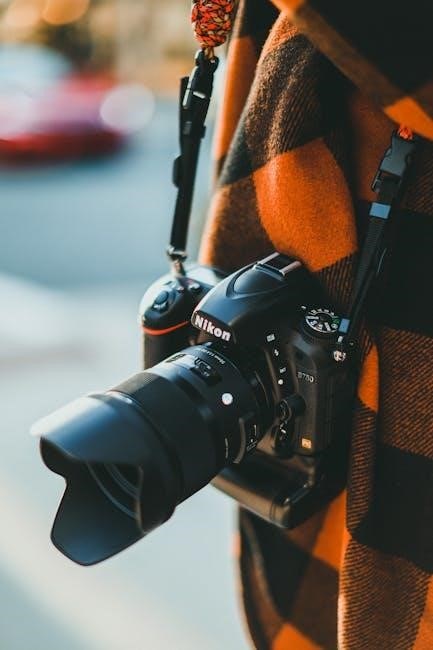Welcome to the Nikon FM2n manual guide. This comprehensive resource provides detailed insights into the camera’s features, operation, and maintenance. Download the PDF manual for free today.
Overview of the Nikon FM2n Camera
The Nikon FM2n is a manual focus 35mm film camera renowned for its durability and reliability. Produced in the 1980s and early 1990s, it features a vertical metal-blade shutter with speeds from 1 to 1/4000 seconds and a flash sync speed of 1/200 seconds. The camera boasts a Nikon F lens mount, compatible with a wide range of Nikkor lenses. Its rugged metal body, bright viewfinder with a split-image rangefinder, and self-timer make it a favorite among professionals. The FM2n operates mechanically without batteries, except for its light meter, which uses LR44 or SR44 batteries. Its minimalist design and precise engineering ensure exceptional performance and image quality, making it a timeless choice for photographers.
Importance of the Manual for photographers
The Nikon FM2n manual is essential for photographers seeking to master this classic camera. It provides detailed guidance on operation, features, and troubleshooting, ensuring optimal use. The manual covers exposure modes, lens compatibility, and maintenance, helping photographers unlock the camera’s full potential. Available in English as a PDF, it’s a valuable resource for both professionals and enthusiasts. Understanding the FM2n’s mechanics and capabilities through the manual allows for precise control, enhancing creativity and image quality. Regular updates and a user-friendly format make it an indispensable tool for anyone working with this iconic film camera.

Key Features of the Nikon FM2n
The Nikon FM2n is a manual-focus 35mm film camera with a mechanical shutter up to 1/4000 sec, Nikon F mount, and a bright viewfinder for precise control.
Design and Build Quality
The Nikon FM2n boasts a rugged, all-metal body, ensuring exceptional durability and reliability. Its classic, minimalist design features a bright viewfinder with a split-image rangefinder and microprism collar for precise focusing. The camera’s mechanical shutter is constructed with vertical metal blades, offering a range of speeds from 1 to 1/4000 seconds. The FM2n’s design emphasizes functionality, with intuitive controls and a solid, professional feel. Its compact size and ergonomic layout make it comfortable to handle, even during extended use. The build quality reflects Nikon’s commitment to craftsmanship, making the FM2n a trusted tool for photographers seeking precision and reliability in a film camera.
Shutter System and Speeds
The Nikon FM2n features a high-precision, mechanically controlled vertical-travel metal focal-plane shutter, offering exceptional durability and accuracy. It provides a wide range of shutter speeds from 1 second to 1/4000 of a second, allowing for flexible control over exposure. The camera also supports flash synchronization at speeds up to 1/200 of a second, enhancing versatility in various lighting conditions. The mechanical shutter ensures reliable operation, even without battery power, making the FM2n a dependable choice for photographers in diverse environments. This robust system is integral to the camera’s reputation for delivering consistent performance and high-quality results in both professional and enthusiast settings.
Metering System and Exposure Control
The Nikon FM2n is equipped with a TTL (Through-The-Lens) full-aperture metering system, providing accurate light measurement. It utilizes a center-weighted metering pattern, ensuring balanced exposures. The camera features a silicon photodiode for precise light detection, enabling reliable results in various lighting conditions. The metering system is compatible with AI-type lenses, allowing seamless integration with modern Nikkor optics. For non-AI lenses, manual meter coupling is required, ensuring compatibility with older glass.
The FM2n offers manual, aperture-priority, and shutter-priority modes, giving photographers full control over exposure; The light meter operates on two LR44 or SR44 batteries, essential for accurate measurements. This system combines simplicity with advanced functionality, making it a versatile tool for both professionals and enthusiasts.
Lens Compatibility and Mount Type
The Nikon FM2n features the iconic Nikon F-mount, ensuring compatibility with a wide range of Nikkor lenses. This versatility allows photographers to use both modern AI-type lenses and older non-AI lenses, making it a versatile choice for enthusiasts and professionals. The F-mount system provides a secure and durable connection, enabling precise control over optical performance. While AI-type lenses offer full-aperture metering and seamless integration, non-AI lenses can still be used with manual meter coupling, ensuring compatibility across generations of Nikon glass. This adaptability makes the FM2n a favorite among collectors and shooters who value both legacy and modern optics.

Lens Compatibility and Metering
The Nikon FM2n supports the Nikon F-mount system, compatible with AI-type lenses for full-aperture metering and non-AI lenses with manual meter coupling, ensuring versatile optical performance.
Understanding AI-Type Lenses
AI-type lenses, introduced by Nikon, feature meter coupling ridges on their aperture rings, enabling full-aperture metering with the FM2n. This system automatically adjusts the aperture, ensuring precise exposure control. The FM2n’s built-in metering system reads the lens aperture through these ridges, allowing for accurate light measurement without manual adjustments. This functionality enhances shooting efficiency, especially in changing lighting conditions. All modern Nikon lenses are AI-type, making the FM2n compatible with a wide range of optics. The AI system streamlines the photography process, offering photographers a seamless and intuitive experience.
Non-AI Lenses and Meter Coupling
Non-AI lenses lack the meter coupling ridges found on AI-type lenses, which means they cannot automatically communicate with the FM2n’s metering system. To use Non-AI lenses, photographers must manually stop down the aperture and use the camera’s metering system in a stopped-down mode. This process, while less convenient, still allows for accurate exposure control. The FM2n’s compatibility with Non-AI lenses is limited compared to AI-type lenses, but it remains a useful feature for photographers with older or third-party optics. Understanding this compatibility is essential for optimizing the camera’s performance with various lenses.

Exposure Modes and Operation
The Nikon FM2n offers manual and aperture priority modes, providing precise control over exposure settings. Manual mode allows full control, while aperture priority offers convenience for professionals and enthusiasts.
Manual Mode and Full Control
In Manual Mode, the Nikon FM2n offers full control over both aperture and shutter speed, allowing photographers to fine-tune their settings for precise exposures. This mode is ideal for experienced shooters who prefer direct command over camera functions. The FM2n’s mechanical shutter system operates without batteries, ensuring reliability even in challenging conditions. Additionally, the camera’s TTL full-aperture metering system provides accurate light measurements, aiding in achieving the perfect exposure. With its durable construction and intuitive controls, the FM2n empowers photographers to explore their creativity without compromise. This mode is particularly favored by professionals seeking ultimate flexibility and consistency in their work.
Aperture Priority and Shutter Priority
The Nikon FM2n offers Aperture Priority and Shutter Priority modes, providing photographers with semi-automatic control over exposures. In Aperture Priority, users set the aperture, and the camera adjusts the shutter speed for optimal exposure. This mode is ideal for controlling depth of field. Shutter Priority allows setting the shutter speed, with the camera adjusting the aperture, perfect for capturing motion or freezing moments. Both modes leverage the camera’s TTL full-aperture metering system, ensuring accurate light measurements. These modes strike a balance between manual control and automation, making them versatile for various shooting scenarios. The FM2n’s reliability and precision in these modes make it a favorite among photographers seeking flexibility without full manual operation.

Technical Specifications
The Nikon FM2n features shutter speeds from 1 to 1/4000 sec, flash sync at 1/200 sec, and a vertical metal-blade shutter. It uses LR44/SR44 batteries for metering, has a durable metal body, Nikon F-mount compatibility, and supports multiple exposures. The camera includes a self-timer and a bright viewfinder with split-image rangefinder and microprism collar for precise focusing.
Shutter Speeds and Sync Flash
The Nikon FM2n offers an impressive range of shutter speeds, from 1 second to 1/4000th of a second, providing precise control over exposure. Its vertically traveling metal-blade focal-plane shutter ensures durability and accuracy. The camera supports flash synchronization at speeds up to 1/200th of a second, allowing for effective use of external flash units. This feature is particularly useful for capturing well-lit subjects in various lighting conditions. The FM2n’s mechanical shutter operates independently of its battery-powered light meter, ensuring reliable performance even without power. These specifications make the FM2n a versatile tool for photographers seeking both creative control and technical precision in their work.
Viewfinder and Focusing Screens
The Nikon FM2n features a bright and clear viewfinder designed for precise composition and focusing. It incorporates a split-image rangefinder and a microprism collar, enabling accurate manual focusing. The standard focusing screen is Type K2, which provides a clear view for framing and focusing. Additionally, optional screens like Type B2 are available, offering a matte/Fresnel surface with a central focusing spot for enhanced precision. These features make the FM2n’s viewfinder highly functional, catering to the needs of photographers who value manual control and optical clarity. The combination of a robust viewfinder and interchangeable focusing screens ensures versatility for various shooting scenarios, making the FM2n a reliable choice for professional and enthusiast photographers alike.

Maintenance and Troubleshooting
Regular maintenance ensures optimal performance. Clean the viewfinder, shutter, and lens regularly. Troubleshoot common issues like stuck shutters or inaccurate light meter readings for reliable operation.
Cleaning and Servicing the Camera
Regular cleaning and servicing are essential to maintain the Nikon FM2n’s performance. Use a soft, dry cloth or a microfiber brush to gently remove dust and debris from the viewfinder, lens, and external surfaces. Avoid harsh chemicals or abrasive materials that could damage the camera’s finish. For the shutter, use compressed air to remove particles, but avoid touching the curtains directly. The light meter and internal mechanisms should be serviced by a professional to ensure accuracy and functionality. Routine maintenance, such as lubrication of mechanical components, is recommended every 5-7 years or as needed. Always refer to the manual for specific guidance on cleaning and servicing procedures to preserve the camera’s longevity and reliability. Proper care ensures the FM2n continues to deliver exceptional results for years to come.
Common Issues and Solutions
Photographers using the Nikon FM2n may encounter occasional issues, such as inaccurate meter readings or shutter malfunctions. One common problem is improper lens compatibility, particularly with non-AI lenses, which may not meter correctly. To resolve this, ensure all lenses are AI-type or manually stop down for accurate exposure. Another issue is the shutter system, which can be affected by improper use of flash sync speeds or extreme temperatures. Always follow the manual’s guidelines for flash synchronization and avoid exposing the camera to harsh conditions; Additionally, battery life for the light meter can be a concern; replace LR44 or SR44 batteries if the meter is inconsistent. For persistent issues, consult the manual or seek professional servicing to maintain optimal performance and extend the camera’s lifespan. Proper care and troubleshooting ensure the FM2n remains a reliable tool for photographers.
The Nikon FM2n manual is an essential guide for mastering this reliable, durable film camera. Its comprehensive instructions ensure optimal performance, making it a timeless tool for photographers.

Final Thoughts on the Nikon FM2n Manual
The Nikon FM2n manual is a vital resource for photographers seeking to fully utilize this iconic camera. Available for free as a PDF, it provides detailed instructions on operation, lens compatibility, and maintenance. With its durable design and mechanical reliability, the FM2n remains a favorite among professionals and enthusiasts. The manual’s clarity ensures that users can master features like manual mode, aperture priority, and shutter speed settings. Whether troubleshooting common issues or understanding metering systems, this guide offers comprehensive support. Its availability in multiple languages and formats makes it accessible to a global audience, ensuring the Nikon FM2n’s legacy endures in the world of photography.